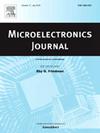一种单电感多输出降压/升压DC-DC变换器,具有抑制自调节和通过储能通道的交叉调节
IF 1.9
3区 工程技术
Q3 ENGINEERING, ELECTRICAL & ELECTRONIC
引用次数: 0
摘要
本文介绍了一种利用储能通道有效提高自调节(SR)和交叉调节(CR)性能的单电感多输出降压/升压DC-DC变换器。利用额外的通道,能量存储和分配方法(ESDM)通过并联电力输送扩展充电控制和SR来抑制CR。此外,该转换器还可以根据负载情况在连续导通模式(CCM)和低功率模式(LPM)之间无缝转换,从而提高负载能力和整体效率。该转换器采用标准的0.18 μm 1.8 V/3.3 V CMOS工艺。仿真结果表明,该设计的SR小于0.056 mV/mA,比传统充电控制方法降低15.9倍;CR小于0.027 mV/mA,比传统充电控制方法降低10.7倍。该变流器的峰值效率为92.3%,在1 mW的轻负荷下保持了88.2%的效率。本文章由计算机程序翻译,如有差异,请以英文原文为准。
A single-inductor multiple-output buck/boost DC–DC converter with both suppressed self-regulation and cross-regulation via an energy storage channel
A single-inductor multiple-output buck/boost DC–DC converter that utilizes an energy storage channel to effectively improve the performance in both self-regulation (SR) and cross-regulation (CR) is presented in this article. With the extra channel, the energy storage and distribution method (ESDM) suppresses CR by extending charge control and SR through parallel power delivery. Additionally, the converter facilitates a seamless transition between continuous conduction mode (CCM) and low power mode (LPM) based on load conditions, thereby enhancing load capacity and overall efficiency. The converter is implemented in a standard 0.18-m 1.8 V/3.3 V CMOS process. Simulation results indicate that the SR of the proposed design is less than 0.056 mV/mA, achieving a 15.9 reduction compared to the conventional charge control method, while CR is less than 0.027 mV/mA, with a 10.7 reduction. The converter achieves a peak efficiency of 92.3% and maintains an efficiency of 88.2% at a light load of 1 mW.
求助全文
通过发布文献求助,成功后即可免费获取论文全文。
去求助
来源期刊

Microelectronics Journal
工程技术-工程:电子与电气
CiteScore
4.00
自引率
27.30%
发文量
222
审稿时长
43 days
期刊介绍:
Published since 1969, the Microelectronics Journal is an international forum for the dissemination of research and applications of microelectronic systems, circuits, and emerging technologies. Papers published in the Microelectronics Journal have undergone peer review to ensure originality, relevance, and timeliness. The journal thus provides a worldwide, regular, and comprehensive update on microelectronic circuits and systems.
The Microelectronics Journal invites papers describing significant research and applications in all of the areas listed below. Comprehensive review/survey papers covering recent developments will also be considered. The Microelectronics Journal covers circuits and systems. This topic includes but is not limited to: Analog, digital, mixed, and RF circuits and related design methodologies; Logic, architectural, and system level synthesis; Testing, design for testability, built-in self-test; Area, power, and thermal analysis and design; Mixed-domain simulation and design; Embedded systems; Non-von Neumann computing and related technologies and circuits; Design and test of high complexity systems integration; SoC, NoC, SIP, and NIP design and test; 3-D integration design and analysis; Emerging device technologies and circuits, such as FinFETs, SETs, spintronics, SFQ, MTJ, etc.
Application aspects such as signal and image processing including circuits for cryptography, sensors, and actuators including sensor networks, reliability and quality issues, and economic models are also welcome.
 求助内容:
求助内容: 应助结果提醒方式:
应助结果提醒方式:


